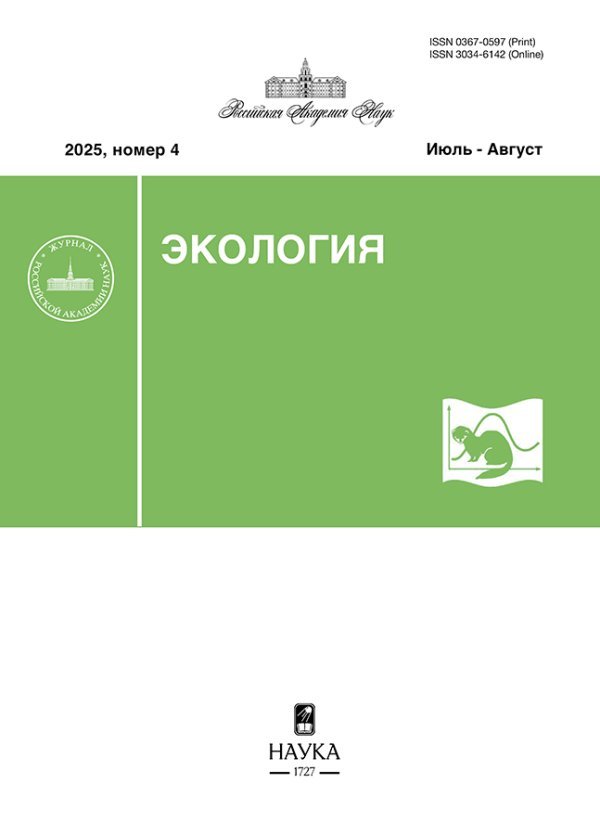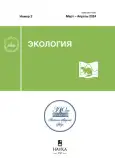No 2 (2024)
Articles
Impact of ice rain on forests of Russky Island
Abstract
Hazardous weather events, which are increasing in frequency with global climate change, pose a threat to forest ecosystems over large areas. Heavy and destructive icy rain occurred in the south of Primorye on November 19, 2020. As a result of the breaking of branches and trunks on the territory of Russky Island, which is part of the Vladivostok urban district, 9.4 ± 1.7 m3/ha of dead fallen wood, which amounted to 4.8% of the total stock of stem wood, was produced. More than a third of all trees lost 50% of their crown. Specific losses of crown phytomass, calculated using regional allometric equations, are estimated at 12.2 ± 2.1 t/ha. The species that were most vulnerable to ice rain (Tilia amurensis and Betula dahurica) were represented by the largest trees, with a wide crown and a large proportion of branches in the total biomass. Lower canopy species (Carpinus cordata and Acer mono) were less affected. The share of the fallen stock of the forest stand (in relation to the total stock) was positively related to the height above sea level (R2 = 0.54, p = 0.039), and the average diameter of the stand was significantly correlated with the phytomass of the fallen part of the crowns (R2 = 0.51, p = 0.047). NDVI vegetation index values obtained from MODIS images for the 2020 and 2021 seasons (before and after the disturbance, respectively) differed significantly.
 77-85
77-85


Structure of cenopopulations of Heracleum sosnowskyi and mechanisms for maintaining their stability in north conditions
Abstract
The growth and productivity, rhythm of development, ontogenetic and spatial structure of cenopopulations of Sosnowsky's hogweed (Heracleum sosnowskyi Manden.) on the territory of the Komi Republic were studied. The duration of the growing season of H. sosnowskyi was 180–190 days due to the early spring germination of seeds and the long autumn growing season of pregenerative individual plants. The studied H. sosnowskyi CPs were characterized by left-sided ontogenetic spectra and high recovery indices. These properties characterized them as young and self-renewing plants. The greatest and the lowest numbers per the unit area had the juvenile and the generative plants (710–1700 and 1–3 individuals/m2, respectively). The average density of immature and virginile individuals was 4–7 pcs/m2 and 12–16 pcs/m2, respectively. The absence of seedlings during the flowering period of plants was discovered, resulting from of the synchronous germination of mericarps and the rapid passage of the post-emergence development stage. Plants began to flower at the age of 2–6 full years, the maximum lifespan of individuals was 7 years. H. sosnowskyi plants were characterized by high productivity. They formed up to 15 kg/m2 of wet phytomass, half of which was produced by generative individuals. The main part of the leaf area of the generative individuals was located in the upper layers (like an “inverted pyramid”) and absorbed about 70% of the incoming PAR. The identified mechanisms of the CP self-maintenance mediate the spread and retention of occupied territories which are occupied by H. sosnowskyi plants on the northern border of the invaded range.
 86-96
86-96


Non-specific animal esterases as biomarkers of pesticide pollution of aquatic ecosystems (review)
Abstract
Pollution of water resources with pesticides negatively affects aquatic organisms and makes water bodies unsuitable for use by humans. Chemical analysis methods do not provide information about the impact of a detected substance and its individual components on the ecosystem. The article presents an analysis and synthesis of published data on the possibilities and features of the use of aquatic enzymes as biomarkers of pollution of aquatic ecosystems with pesticides. Publications over the past 20 years, indexed in the PubMed, Crossref, Web of Science, Scopus, and RSCI databases devoted to the issues of pesticide pollution of water bodies and the use of enzymes, in particular nonspecific esterases, in biomonitoring were analyzed. The concept of “biomarker” is revealed, groups of biomarkers, the purposes of their use, advantages and disadvantages as a source of information about the state of the ecosystem are listed. Particular attention is paid to study of nonspecific esterases in aquatic organisms (fish, mollusks, crustaceans, amphibians). The main types of substrates used to measure the activity of esterase isoforms and the features of changes in enzymatic activity in response to exposure to pesticides from different chemical groups (organophosphorus compounds, carbamates, pyrethroids) are considered. The factors influencing the activity of nonspecific esterases of aquatic organisms and limiting their use for assessing pollution of aquatic ecosystems are identified.
 97-111
97-111


On the issue of the primary sex ratio in the pied flycatcher (Ficedula hypoleuca)
Abstract
An assessment of the primary sex ratio in the local pied flycatcher population in South Karelia (Russia) is given and its variations in broods depending on breeding characteristics and characteristics of the parents are analyzed. The proportion of males in 30 clutches examined in 2012 did not differ from the proportion of females and amounted to 50.8% of the total number of eggs laid (n = 199), although it varied from 14.3% to 85.7% in individual nests. A weak positive correlation between the proportion of males in the brood and the timing of breeding and the ornamentation of the feathers that form the white spot on the male’s wing (the first tertiary and the 5–6th upper greater coverts of the secondary feathers), and a negative correlation with the length of the wing and the third primary feather of the female were shown. Analysis using generalized linear models showed a significant relationship of primary sex ratio in the brood only with the length of the female’s third primary feather. Possible mechanisms of changes in the sex ratio in broods are discussed.
 112-122
112-122


Functional alpha diversity: a new distance-based measurement calculations technique that accounts for intraspecific variability
Abstract
A new technique for assessing functional diversity is proposed, which is essentially a way to calculate Rao’s quadratic entropy. In contrast to the original method of calculating entropy, the new method takes into account intraspecific variability and allows us to evaluate other useful aspects of functional diversity, such as functional richness, functional evenness, the uniqueness of each species, and the contributions to functional diversity of intraspecific variability of each species and each trait separately. However, due to the peculiarities of the calculation, the proposed technique can only be applicable for an absolute count of all organisms within the “island” community or when collecting material based on a fixed sampling effort. The article provides an example of the application of the proposed technique to real rodent trapping data.
 123-136
123-136


Comparative analysis of blood system indicators of three species of immature forest voles under conditions of low autumn temperatures
Abstract
Quantitative structural and functional indicators of the blood system were studied in immature autumn individuals of closely related species: bank, red, and red-gray voles (18, 11, and 9 individuals, respectively), constituting a reserve population in the autumn–winter period, to assess the adaptive response to low temperature conditions. Interspecies differences in the size of the diffusion surface and the degree of hemoglobinization of erythrocytes, typical for each species, have been identified. The three species of voles with a similar ability to carry oxygen per unit volume of blood have different mechanisms for providing tissues with oxygen. The identified differences in the responses of blood parameters (reticulocytes, erythrocyte indices, and leukocyte composition) reflect the physiological mechanism of maintaining hemoglobin concentration in the blood, being therefore of great importance in solving issues of homeostasis of the body in a changing environment. Based on a set of experimental data, groups of voles (taxonomy) corresponding to the classification of species were identified using discriminant analysis.
 137-147
137-147


Communities of soil-living enchytraeids (Annelida, Clitellata, Enchytraeidae) of the European part of Russia
Abstract
Enchytraeids are key organisms in the functioning of terrestrial ecosystems, but despite this, the fauna and population of enchytraeids of the European part of Russia (ER) have been studied rather poorly. Based on our own collections from 193 sites across the main biomes of the ER from 2019 to 2023, 74 species of enchytraeids belonging to 15 genera were identified. The presence of tundra, boreal, nemoral and desert faunal complexes of enchytraeids, as well as a group of polyzonal species, was shown. From a faunal perspective, the Caucasus, which is inhabited by a group of species that are not found anywhere else in Russia, stands out within the ER. Analysis of enchytraeid communities in various biomes of the ER at the species level will allow for a more correct assessment of their role in detrital food webs and the functioning of ecosystems overall.
 148-157
148-157


Short communications
State of zooplankton communities in lakes Bannoe (Solovetsky archipelago) and Kholmovskoe (Northern Dvina river basin)
 158-162
158-162










